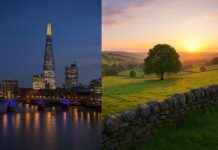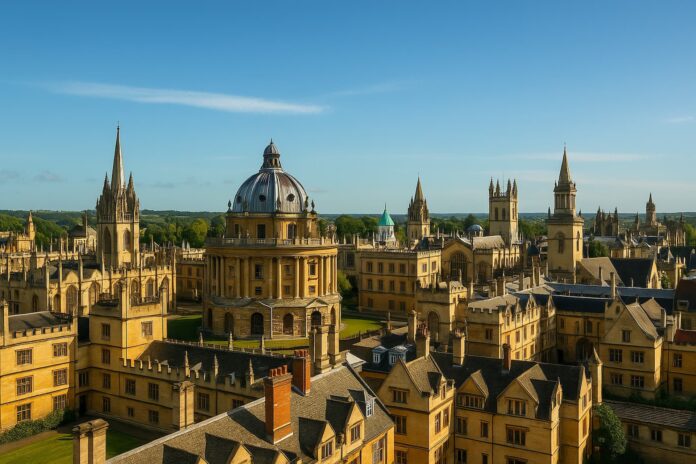Oxford isn’t just a university city—it’s a place full of surprises, quirky traditions, and world-changing history. From secret tunnels beneath libraries to ancient festivals that still thrive today, Oxford has plenty of hidden gems. Here are 14 fascinating facts that will make you see the “City of Dreaming Spires” in a whole new light.
Introduction
Oxford is instantly recognised for its stunning colleges and centuries-old university. But if you think that’s all there is to know, think again. Beyond the textbooks and spires lies a city rich with hidden history, eccentric traditions, and cultural gems that many visitors overlook.
This city has shaped literature, politics, science, and even pop culture. With markets that haven’t changed for centuries, pubs that inspired fantasy worlds, and festivals that date back hundreds of years, Oxford has layers waiting to be explored. Let’s dive into 14 things you probably didn’t know about Oxford—but definitely should.
1. The Oldest University in the English-Speaking World
Oxford University dates back to the 12th century, making it older than the Magna Carta. Students were learning here when knights still roamed medieval England! Today, it remains a powerhouse of research and global education.
- Founded: 1096 (teaching recorded).
- Over 30 Prime Ministers studied here.
- Alumni include Stephen Hawking, Oscar Wilde, and Malala Yousafzai.
💡 Did You Know? Oxford students once fled to Cambridge during riots in 1209—leading to the birth of Cambridge University.
2. The City of Dreaming Spires
Poet Matthew Arnold gave Oxford this poetic title after admiring the skyline. From Radcliffe Camera to Magdalen Tower, the views are a blend of medieval and neoclassical elegance.
- Around 38 colleges shape the skyline.
- The Radcliffe Camera is one of the most photographed spots.
💡 Did You Know? Oxford’s skyline has been protected by strict building regulations since the 1960s. No modern skyscraper can block those iconic spires.
3. Home to the World’s Oldest Museum
The Ashmolean Museum, founded in 1683, is the oldest public museum in the world. It set the model for museums everywhere.
- Exhibits range from Egyptian mummies to Japanese art.
- Free entry makes it accessible to everyone.
💡 Did You Know? The Ashmolean once housed Guy Fawkes’ lantern—the same man behind the Gunpowder Plot of 1605.
4. A Library Bigger Than You Think
The Bodleian Library is a book lover’s paradise with more than 13 million items. It is so big that many books are stored underground and accessed via tunnels.
- Legal deposit library: receives every UK-published book.
- Iconic reading rooms like the Radcliffe Camera.
💡 Did You Know? J.R.R. Tolkien and C.S. Lewis often researched here while writing The Lord of the Rings and The Chronicles of Narnia.
5. Harry Potter Filming Locations
Oxford is Hogwarts come to life. Many Harry Potter scenes were filmed in its colleges.
- Christ Church dining hall inspired Hogwarts’ Great Hall.
- Divinity School served as the Hogwarts infirmary.
- New College cloisters feature in Goblet of Fire.
💡 Did You Know? Fans often spot small differences in films—like when the Bodleian doubled as different Hogwarts rooms.
6. Punting on the Thames (or the Cherwell)
A classic Oxford activity is punting—a flat-bottomed boat pushed with a pole along the river. It’s tricky at first but offers a unique way to see the city.
- Best in summer with picnics and wine.
- A favourite student pastime.
💡 Did You Know? Locals debate whether it’s better to stand at the front or back of the punt—Oxford and Cambridge do it differently!
7. The Covered Market’s Timeless Appeal
Opened in 1774, the Covered Market still thrives as Oxford’s shopping heart.
- Fresh produce, butchers, florists, and quirky stalls.
- Local favourites like Moo-Moo milkshakes and Oxford Blue cheese.
💡 Did You Know? Many shops in the market are family-run businesses passed down for generations.
8. An Inspiring Literary City
Oxford is a dreamland for book lovers.
- Lewis Carroll wrote Alice’s Adventures in Wonderland here.
- Tolkien and Lewis were part of The Inklings group.
- Philip Pullman’s His Dark Materials is set in an alternate Oxford.
💡 Did You Know? Alice Liddell—the real-life girl who inspired Alice in Wonderland—was the daughter of the Dean of Christ Church.
9. A City of Bicycles
Cycling is Oxford’s lifeblood. Narrow streets and thousands of students mean bikes outnumber cars.
- Around 25% of residents cycle to work.
- Dedicated bike lanes cover the city.
💡 Did You Know? Oxford’s bike racks hold more than 20,000 cycles daily!
10. The Oldest Botanic Garden in Britain
Founded in 1621, Oxford Botanic Garden is the UK’s oldest.
- Over 5,000 plant species.
- Still used for teaching and research.
💡 Did You Know? The Botanic Garden appears in Philip Pullman’s novels as a romantic meeting spot.
11. A City at War with Cambridge
Oxford and Cambridge share one of the world’s greatest rivalries.
- The annual Boat Race began in 1829.
- Competition extends to academics, sports, and traditions.
💡 Did You Know? In rowing, Cambridge currently leads overall wins—but Oxford often stages dramatic comebacks.
12. Unique Traditions: May Morning
Every May 1st, Oxford wakes up to a festival like no other.
- Choir sings from Magdalen College Tower at dawn.
- Streets fill with dancing, music, and food.
💡 Did You Know? Centuries ago, students celebrated May Morning by jumping off Magdalen Bridge into the river—a tradition banned for safety!
13. A Hub for Science and Discovery
Oxford has shaped the modern world.
- Discovery of penicillin.
- Breakthroughs in computing and AI.
- Covid-19 Oxford-AstraZeneca vaccine.
💡 Did You Know? The Oxford Electric Bell—installed in 1840—is still ringing today and holds the Guinness World Record for the longest-running battery.
14. Pubs with a Story to Tell
Oxford’s pubs are living history.
- The Eagle and Child hosted Tolkien & Lewis.
- The Turf Tavern is centuries old and famously hard to find.
- Pubs are still central to student and academic life.
💡 Did You Know? Bill Clinton reportedly “did not inhale” at Oxford—and the Turf Tavern has a plaque joking about it.
FAQs
1. Why is Oxford called the “City of Dreaming Spires”?
The nickname comes from poet Matthew Arnold, who admired the skyline of Oxford’s spires and towers. It highlights the city’s mix of beauty, scholarship, and timeless architecture. Today, those spires are still a protected part of Oxford’s identity and remain one of its most iconic features.
2. What is the Bodleian Library famous for?
The Bodleian is one of Europe’s oldest and largest libraries, with over 13 million items. It houses Shakespeare’s First Folio and countless rare manuscripts. Its underground storage and iconic reading rooms make it a must-visit for book lovers and history enthusiasts alike.
3. Can you visit Oxford colleges?
Yes, many colleges welcome visitors. Christ Church, Magdalen, and Balliol are favourites, offering gardens, chapels, and dining halls. Entry fees are usually modest, and tours often include fascinating history about traditions, scholars, and events that shaped both Oxford and the world.
4. What’s the best way to explore Oxford?
Walking and cycling are the easiest ways to see Oxford. Guided tours reveal hidden stories, while punting offers a scenic river view. The city centre is compact, so visitors can explore colleges, museums, markets, and historic streets within a single day or weekend.
5. Is Oxford just about the university?
Not at all. While the university is central, Oxford also boasts markets, music festivals, green parks, riverside walks, and lively restaurants. Its combination of history and modern culture makes it appealing to both locals and visitors seeking more than just academic heritage.
6. When is the best time to visit Oxford?
Spring and summer are popular, with gardens in bloom and May Morning festivities. Autumn adds magical colours and fewer crowds, while winter creates a cosy atmosphere with Christmas markets and pubs. Each season has its charm, so Oxford is truly a year-round destination.
7. Are there free attractions in Oxford?
Yes, plenty! The Ashmolean and Pitt Rivers Museums are free, while the Botanic Garden is affordable. Exploring covered markets, historic lanes, and riverside walks also costs nothing. With so many free activities, Oxford offers culture and history without straining your budget.
Conclusion
Oxford is much more than an academic hub—it’s a city where history, literature, science, and tradition come alive in every corner. From punting down the river to exploring museums older than many nations, it offers something unique for everyone.
Its quirks, like May Morning and legendary pubs, blend seamlessly with world-changing achievements in science and literature. Oxford remains timeless—a city where the past and present walk hand in hand, waiting to be discovered by curious travellers.



























